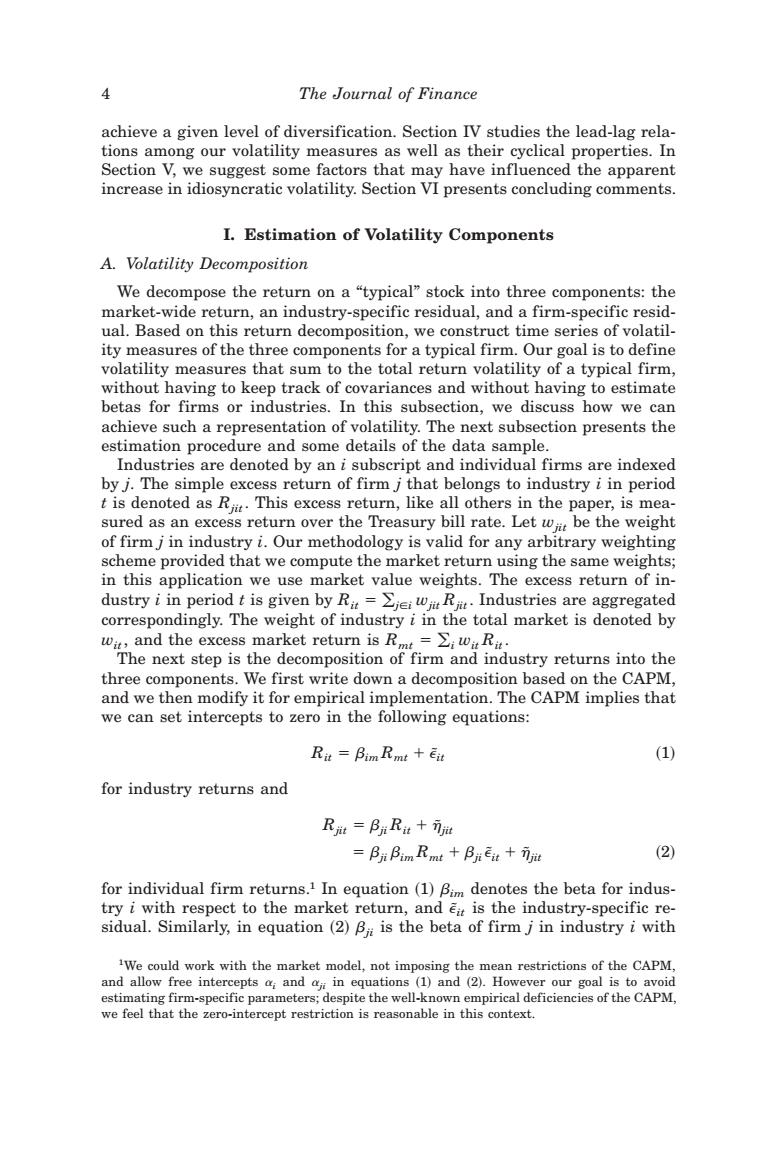正在加载图片...

4 The Journal of Finance achieve a given level of diversification.Section IV studies the lead-lag rela- tions among our volatility measures as well as their cyclical properties.In Section V,we suggest some factors that may have influenced the apparent increase in idiosyncratic volatility.Section VI presents concluding comments. I.Estimation of Volatility Components A.Volatility Decomposition We decompose the return on a "typical"stock into three components:the market-wide return,an industry-specific residual,and a firm-specific resid- ual.Based on this return decomposition,we construct time series of volatil- ity measures of the three components for a typical firm.Our goal is to define volatility measures that sum to the total return volatility of a typical firm, without having to keep track of covariances and without having to estimate betas for firms or industries.In this subsection,we discuss how we can achieve such a representation of volatility.The next subsection presents the estimation procedure and some details of the data sample. Industries are denoted by an i subscript and individual firms are indexed by j.The simple excess return of firm j that belongs to industry i in period t is denoted as Rit.This excess return,like all others in the paper,is mea- sured as an excess return over the Treasury bill rate.Let wiit be the weight of firm j in industry i.Our methodology is valid for any arbitrary weighting scheme provided that we compute the market return using the same weights; in this application we use market value weights.The excess return of in- dustry i in period t is given by Ri=jewRIndustries are aggregated correspondingly.The weight of industry i in the total market is denoted by wit,and the excess market return is Rmt=iwit Rit. The next step is the decomposition of firm and industry returns into the three components.We first write down a decomposition based on the CAPM, and we then modify it for empirical implementation.The CAPM implies that we can set intercepts to zero in the following equations: Rit =Bim Rmt Eit (1) for industry returns and Rm=B:Rt+可m =B元Bim Rmt+B元et+it (2) for individual firm returns.1 In equation (1)Bim denotes the beta for indus- try i with respect to the market return,and e is the industry-specific re- sidual.Similarly,in equation(2)B is the beta of firmjin industry i with We could work with the market model,not imposing the mean restrictions of the CAPM, and allow free intercepts a;and a in equations (1)and (2).However our goal is to avoid estimating firm-specific parameters;despite the well-known empirical deficiencies of the CAPM, we feel that the zero-intercept restriction is reasonable in this context.achieve a given level of diversification. Section IV studies the lead-lag relations among our volatility measures as well as their cyclical properties. In Section V, we suggest some factors that may have influenced the apparent increase in idiosyncratic volatility. Section VI presents concluding comments. I. Estimation of Volatility Components A. Volatility Decomposition We decompose the return on a “typical” stock into three components: the market-wide return, an industry-specific residual, and a firm-specific residual. Based on this return decomposition, we construct time series of volatility measures of the three components for a typical firm. Our goal is to define volatility measures that sum to the total return volatility of a typical firm, without having to keep track of covariances and without having to estimate betas for firms or industries. In this subsection, we discuss how we can achieve such a representation of volatility. The next subsection presents the estimation procedure and some details of the data sample. Industries are denoted by an i subscript and individual firms are indexed by j. The simple excess return of firm j that belongs to industry i in period t is denoted as Rjit. This excess return, like all others in the paper, is measured as an excess return over the Treasury bill rate. Let wjit be the weight of firm j in industry i. Our methodology is valid for any arbitrary weighting scheme provided that we compute the market return using the same weights; in this application we use market value weights. The excess return of industry i in period t is given by Rit 5 (j[i wjit Rjit . Industries are aggregated correspondingly. The weight of industry i in the total market is denoted by wit, and the excess market return is Rmt 5 (i wit Rit . The next step is the decomposition of firm and industry returns into the three components. We first write down a decomposition based on the CAPM, and we then modify it for empirical implementation. The CAPM implies that we can set intercepts to zero in the following equations: Rit 5 bim Rmt 1 eI it ~1! for industry returns and Rjit 5 bji Rit 1 hI jit 5 bji bim Rmt 1 bji eI it 1 hI jit ~2! for individual firm returns.1 In equation ~1! bim denotes the beta for industry i with respect to the market return, and eI it is the industry-specific residual. Similarly, in equation ~2! bji is the beta of firm j in industry i with 1 We could work with the market model, not imposing the mean restrictions of the CAPM, and allow free intercepts ai and aji in equations ~1! and ~2!. However our goal is to avoid estimating firm-specific parameters; despite the well-known empirical deficiencies of the CAPM, we feel that the zero-intercept restriction is reasonable in this context. 4 The Journal of Finance